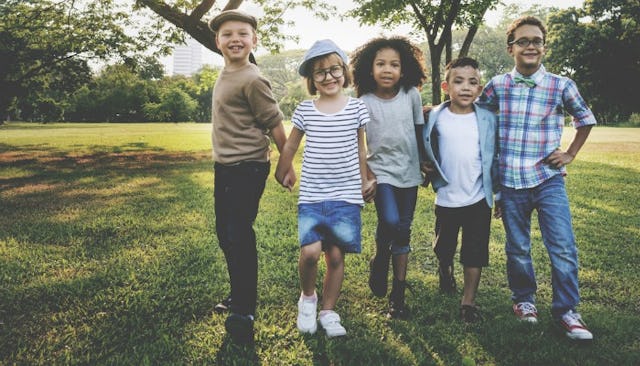Raising Colorblind Kids Isn't the Point, Raising Empathetic Kids Is

When a story about a little white boy who wanted to get his hair cut short like his black friend so that the teacher “wouldn’t be able to tell them apart” went viral recently, I thought it was adorable. There was something about the two little boys that reminded me of myself and my childhood best friend.
We’ve been best friends since we were 3 years old, and we’ve pretty much always been aware of the fact that she is white and I am black and that we’re obviously different from each other. The biggest thing our families taught us was to embrace our differences because they don’t make one of us less-than or more-than the other; it means we have diverse perspectives and experiences to share with each other. And we have embraced those differences, which has led to our enduring relationship, now 30 years strong. Our friendship is priceless.
As a woman of color, one of my biggest issues with some of the responses to the story of these two boys is that people are jumping on the word “privilege” because the white mother (who penned the original post) mentioned that making their racial difference an issue is a learned — and therefore taught — way of thinking that children are not inherently equipped with. The mother’s comments lacked a certain vocabulary and nuance that people needed to feel comfortable with what was happening in the story.
Some people said that her white son wanting to get his hair buzzed short like his black friend, because he wanted to look like him, fed into the concept of “colorblindness,” a way of approaching race that many white folks will proudly tout in the face of racial issues and tensions in America. While it is often well-intended, the concept is severely misguided.
But while the “colorblind” theory may be at play here, it’s important to note that this is a social media post and we have no background knowledge of the kinds of conversations surrounding race that these parents are having with their boys. The odds of colorblindness here are slim to none; these two boys definitely know that their skin color is not the same — children are smart enough to see that. What is important here is what the adults in their lives are doing to help them understand those differences in a way that is age-appropriate but also honest and straightforward.
In 2017, not acknowledging different races hinders the goal of raising children to coexist in a racially diverse world. It is simply an unrealistic approach. The key is to teach children that their differences don’t make them any better or worse than their friends or anyone else for that matter. We may think that something like this would be obvious, but it needs to be spelled out, especially for children.
The easiest way to do this is to acknowledge how we as adults treat and talk about people of other races. We may not think that children are listening, but they are. They look to the adults in their lives as examples. It’s not enough to say, “Black lives matter,” or “I care about immigrants.” You have to show that in a way that is realistic and organic.
Buy your children books and toys that feature characters of different races. Integrating a book into their nightly rotation that features a marginalized character is easy, but don’t just use stories about prominent historical figures. Choose ones that feature everyday characters. Sure, it’s great to teach your kid about Rosa Parks, but reading a book about a kid just like them brings the message to their level in a more tangible way. Encourage them to be friends with kids who are different from them.
Acknowledging the unique struggles that marginalized children may face is also important. Tempering the conversation to the comprehension level of your child, you can explain issues that their peers might face. In the case of the viral matching haircuts story, maybe that little boy’s mother did explain to her son that even though he and his friend want to look alike, there are inherent differences that they face and will continue to face as they grow up. I hope she did. When my friend and I were young, she asked for a black doll so she could have a doll that looked like me. I had a white doll that I wanted because it looked like her. Now, as adults, we have no problem talking about racial issues, and we often talk about the challenges that I face as a black woman in today’s society.
Don’t praise yourself for being colorblind either. “I don’t see race” doesn’t actually help anyone. Not being able to confront and talk openly about the different lived experiences POC face is what actually creates divisiveness. Being able to sit your child down and have honest conversations with them about racial, gender, and socioeconomic differences will only make you both stronger allies.
Race is something that isn’t going to go anywhere; it is, however, going to change drastically over the next five to ten years as minorities and mixed race people begin to become the majority. Being able to acknowledge our individual privileges is hugely important in raising self-aware children who will be good friends to those who aren’t exactly like them. It is hard as an adult to unlearn everything that we have been taught over the years, but it is our duty. It is the only way to make the next generations — the generations we are entrusted to raise into good, kind people — do better than the ones before.
This article was originally published on